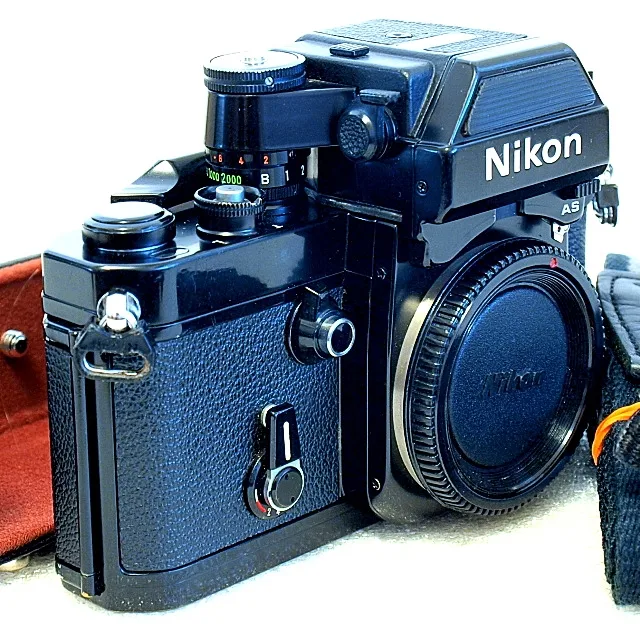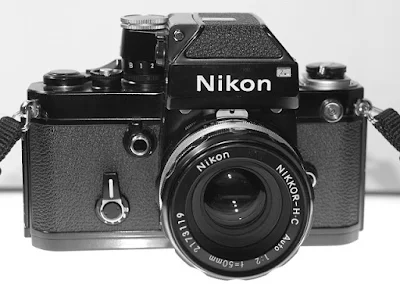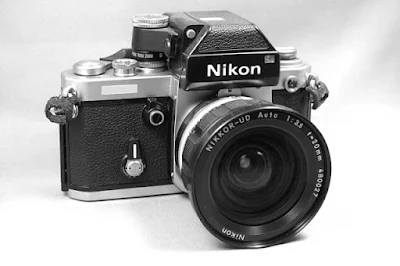Film Camera Review: A look back at the manual focus Nikon F2 Photomic 35mm SLR film camera, one of the world's best production cameras.
<< Click on image for enlarged Lightbox display >>
Professional, best of the breed, world's top 35mm SLRs from 1971 through 1980, and maybe rightly so, the best 35mm SLR camera ever. I, too, had a liking for this camera, and over the last few years, I have collected, used, and sold a few on my sales blog.
Introduced in 1971, the Nikon F2 is a mechanical shutter SLR system camera, made to replace the original Nikon F.
As a system camera, the F2 also comes with a plethora of interchangeable finders, interchangeable focusing screens, 250-exposure backs, motor drives, and more.
During the production run of the Nikon F2, Nikon introduced a new head, or the interchangeable viewfinders, every couple of years or so, which then redefined the version of the camera.
The F2 was also the last all-mechanical professional-level Nikon SLR.
Nikon F2 35mm Film Camera Overview / Review (Part 1)
This is an overview of the Nikon F2 professional 35mm film camera that was produced from 1971 to 1980. The controls and features of the camera are explained ...
The F2 and the F Family
The F2 is the second member of the long line of Nikon F-series professional-level 35 mm SLRs that began with the Nikon F (1959–1974), the F3 (1980–2001), F4(1988–1996), F5 (1996–2005), and F6 (2004–present). The common denominator of the F-series is the F-mount lens system.Over its production evolution, the F2 series carries five different metering heads, thus five different F2 Photomic versions:
- F2 Photomic
- F2 Photomic S
- F2 Photomic SB
- F2 Photomic A
- F2 Photomic AS
The Photomic head requires two S76 or A76, SR44, or LR44 batteries to power its electronics.
Also available for the F2 are the meterless heads: the Nikon DW-1 waist-level finder, the DA-1 action finder, and the DW-2 6X magnifying finder.
Manual Shutter Speeds from 2 to 10 Seconds
Unique to the Nikon F2 is the feature that enables manual shutter speeds from 2 to 10 seconds to be executed repeatedly. This sequence is activated first by setting the shutter button collar to 'T' (Time), followed by setting the shutter speed dial to 'B' (Bulb), before setting the shutter duration using the time scale of the Self-Timer lever. Press the shutter button to execute, and the shutter will open immediately for the time duration set.
Unique to the Nikon F2 is the feature that enables manual shutter speeds from 2 to 10 seconds to be executed repeatedly. This sequence is activated first by setting the shutter button collar to 'T' (Time), followed by setting the shutter speed dial to 'B' (Bulb), before setting the shutter duration using the time scale of the Self-Timer lever. Press the shutter button to execute, and the shutter will open immediately for the time duration set.
Nikon F2 Photomic (1971-1977)
The original Nikon F2 Photomic (1971-1977) came with the Nikon DP-1 head, which had a center-the-needle exposure control system. New features of the original Nikon F include a faster 1/2000 second maximum shutter speed, a hinged back for easier film loading, a wider range of finders and metering heads, a 250 exposure film back, a larger reflex mirror to ensure no vignetting, and a shutter release nearer the front of the camera for better ergonomics.
Nikon F2 Photomic S (1973-1977)
The F2 Photomic S (1973-1977) comes with the DP-2 head, functionally very similar to the DP-1 but with an all-solid-state LED exposure control system. The light meter on the DP-2 has better low-light sensitivity than the DP-1, down to Exposure Value (EV) −2, instead of EV 1, at ASA 100.
Nikon F2 Photomic SB (1976 to 1977)
The F2 Photomic SB (1976 to 1977), with the DP-3 head, introduces three innovations to the lineup: a silicon photodiode light meter (a first for Nikon SLRs) for faster and more accurate light readings, a five-stage LED exposure control system, and an eyepiece blind.
The 'Nikon Shuffle'
The 'Nikon shuffle' is the standard procedure common to F2 users when lenses are fitted to the F2 bodies. The three early Photomic heads required Nikon F-mount lenses that come with the meter coupling shoe, or what is affectionately known as the rabbit ears.
While mounting, the aperture ring on each lens must be turned back and forth to the smallest aperture (largest f-stop number) and then to the largest aperture (smallest f-stop number) to ensure that the lens and the head couple properly.
Strange as it may seem, that was the standard procedure practiced by photographers using Nikon and Nikkormat cameras in the 1960s and 1970s.
The 'Nikon shuffle' is the standard procedure common to F2 users when lenses are fitted to the F2 bodies. The three early Photomic heads required Nikon F-mount lenses that come with the meter coupling shoe, or what is affectionately known as the rabbit ears.
While mounting, the aperture ring on each lens must be turned back and forth to the smallest aperture (largest f-stop number) and then to the largest aperture (smallest f-stop number) to ensure that the lens and the head couple properly.
Strange as it may seem, that was the standard procedure practiced by photographers using Nikon and Nikkormat cameras in the 1960s and 1970s.
Nikon F2 Photomic A
The F2 Photomic A, DP-11 head, and the F2 Photomic AS, DP-12 head (both introduced in 1977) function just like the DP-1 and DP-3 previously, with the exception that these heads now support the Automatic Indexing (AI) feature introduced with the Nikkor AI lenses of 1977. The AI lenses allow for carefree lens mounting, which ends the 'Nikon Shuffle' of Nikon/Nikkormat users from before.
Removing the Finder
To remove the DP-11 from the camera, first press the finder release lever, located on the front-right of the pentaprism, inward and rotate toward the front (this action releases the mounting clamps); and then, depress the finder release button, located on the back of the top plate, and lift the finder gently out of the camera.
To remove the DP-11 from the camera, first press the finder release lever, located on the front-right of the pentaprism, inward and rotate toward the front (this action releases the mounting clamps); and then, depress the finder release button, located on the back of the top plate, and lift the finder gently out of the camera.
Nikon F2 Photomic AS
The F2 Photomic AS, with the DP-12 head, was the most advanced version of the series and has become the most desired and collected F2 today.
Nikon DS-1 or DS-2 EE Aperture Control Units
The F2 Photomic S (DP-2 head) and F2SB Photomic SB (DP-3 head) also accepted the unusual Nikon DS-1 or DS-2 EE Aperture Control Units, a shutter priority auto-exposure system that uses an electric servomotor to set the lens aperture ring in response to the set shutter speed and light meter reading.Focusing Screens
The F2 also came with interchangeable viewfinder focusing screens.Standard Type K screen that has a central 3 mm split image rangefinder and 1 mm microprism collar focusing aids on a matte/Fresnel background, plus a 12 mm etched circle indicating the area of the meter center weighting.
Other options include:
- Type A – Central 3 mm split image rangefinder plus 12 mm etched circle. This was standard with early F2s; the changeover to Type K was around 1976.
- Type B – Central 5 mm focusing spot plus 12 mm etched circle, for close-ups and long telephotos.
- Type C – Central 4 mm clear spot with cross-hair reticle. Very bright, used for photo-microscopy, astrophotography, and parallax focusing methods.
- Type D – Plain matte screen. Best for long telephoto lenses with small apertures.
- Type E – Type B with a grid of 5 horizontal and 3 vertical lines, referred to as the "architectural screen," is excellent for "Rule of Thirds" image composition.
- Type G – Central 12 mm extra-bright microprism without matte background (cannot assess the depth of field), G1–G4 for specific focal length lenses (switching lenses might necessitate switching the screen too).
- Type H – Clear Fresnel field with microprism focusing pattern over the entire screen area. Four versions, H1–H4, for specific focal length lenses.
- Type J – Central 4 mm microprism plus 12 mm etched circle.
- Type L – Type A, but with a rangefinder set at a 45° angle from lower left to upper right, permits focusing on horizontal or vertical subjects.
- Type M – Central 5 mm double crosshairs with marked horizontal and vertical scales, for photo-microscopy.
- Type P - Type L, but adds a 1 mm microprism collar and a full-screen crosshair, originally marketed as the "Apollo P screen," the screen favored by NASA on their Nikon bodies.
- Type R – Type E, but adds a 3 mm split image rangefinder to the center of the screen.
- Type S – for F2 Data, Type A with etched markings for data imprint area.
- Type T – for F2 Type A with etched markings for taking pictures of TV screens.
Accessories
Accessories made available for the F2 include:- Nikon MD-1 (1971) and MD-2 (1973) motor drives, up to 5 frames per second film advance, 6 if the mirror was locked up, plus power rewind. Both require the Nikon MB-1 battery pack, which holds 10 AA or LR6 batteries in two Nikon MS-1 battery clips.
- Nikon MD-3 motor drive is lighter, cheaper, and less capable than the MD-1, with no power rewind, and an advance rate of 2.5 frames/s with the standard MB-2 battery pack holding 8 AA or LR6 batteries.
- Nikon MF-1 (33/10 feet/meters film = 250 frames; required two Nikon MZ-1 film cassettes) and MF-2 (100/30 feet/meters film = 750 frames; required two MZ-2 film cassettes) bulk film backs. The MF-2 and its MZ-2 cassettes are rare finds if you ever chance across them.
- Nikon Speedlight SB-2 (guide number 82/25 (feet/meters) at ASA 100), SB-5 (guide number 105/32 (feet/meters) at ASA 100), SB-6 (guide number 148/45 (feet/meters) at ASA 100) and SB-7E (guide number 82/25 (feet/meters) at ASA 100) electronic flashes, from 1976 onward, mounted in a unique-to-Nikon-F-and-F2 hot-shoe fitted on top of the film rewind crank.
- Nikon ML-1 Modulite, a wireless infrared remote controller with a 200/60 feet/meters line-of-sight range. The ML-1 is a two-part device: a handheld transmitter and a camera-mounted receiver that needs to be connected to a motor drive. The Nikon MW-1 was a similar device, larger and more powerful.
- Nikon MT-1 is an intervalometer that allows completely unattended time-lapse photography.
- Minor accessories include straps, cases, bags, remote firing cords, eyecups, eyepiece correction lenses, supplementary close-up lenses, lens hoods, filters, and cases that are also available for the F2.
In 1978, a complete Nikon photographic system of cameras, lenses, and accessories totaling nearly 450 items was priced at more than US$110,000, the most extensive and expensive system in the world.



















No comments:
Post a Comment